
Fishpond Wood and Beverley Meads is a 5.8 hectare local nature reserve adjacent to Wimbledon Common in the London Borough of Merton. [1] It is owned and managed by Merton Council.

Fishpond Wood and Beverley Meads is a 5.8 hectare local nature reserve adjacent to Wimbledon Common in the London Borough of Merton. [1] It is owned and managed by Merton Council.

In the Middle Ages Beverley Meads was owned by Merton Abbey, from which period the two ponds in Fishpond Wood are believed to date. [2] It is likely that the watermill at Mill Corner on Beverley Brook dated from the medieval period: it was a fulling mill and is believed to have burnt down in the Tudor period. [3] At that period the meads covered the area, since pollen analysis from the ponds indicates that the surrounding woodland developed only after the mill's demise. [4] After the Reformation and the dissolution of Merton Abbey in 1538, the meads continued to be farmed, and was owned by Warren Farm until shortly after the Second World War. [5]
The 'ponds' themselves are curious, for, while they may have been connected to the medieval watermill nearby, they only appear on maps from the early nineteenth century onwards. [6] That said, since the area was described as 'waste' (common land) in the Wimbledon Manorial Rolls of 1763, it is possible that they were never viewed as worthy of recording. [7]
In the 1950s it was acquired by Wimbledon Council for public recreation and the medieval ponds drained. [8] In the 1970s, after Wimbledon Council was subsumed by Merton Council, it was laid out to become a pitch and putt course, which introduced foreign soil and severely damaged the once pervasive acid grassland, before being abandoned in 1981. [9]
In the 1980s it was partly restored, with the northern pond desilted in 1989 and its breaches repaired in 1992, such that it retains water throughout most of the year. [10] In 1993, the area became a local nature reserve. [11] It was for some years managed by London Wildlife Trust. [12] [13]

Fishpond Wood lies adjacent to Warren Farm, and its wetlands are surrounded by old oak-hazel woodland. [14] Around half of the hazel trees in the wood have been managed by coppicing again, although recent regeneration has been poorer, possibly owing to increasing numbers of rabbits and the arrival of muntjac deer. [15] The ponds support a range of amphibians, including frogs (numbering around a thousand), toads and newts, as well as dragonflies and damselflies during the summer months. [16]
A broader variety of fauna live within the wood, including wood mice, bank and short-tailed voles, common and pygmy shrews, and weasels as well as foxes, rabbits and grey squirrels, and, more rarely, pipistrelle bats. [17] Bird life is also abundant and includes lesser and greater spotted and green woodpeckers, tree-creeper and redwings during winter, while mallards, moorhens and occasionally mandarin ducks have bred nearby. [18]

Beverley Meads was used as grazing land before the War, but the four meadows ('meads') are now mostly overgrown and encroached by scrub. [19] The remnants of the old meadows provide acid grassland, which is a rare habitat in London and important for wildlife, especially grassland butterflies. [20] The encroachment is being battled, and scrub pushed back to encourage this grassland to recover. [21] Local butterflies include large, Essex and small skippers, small coppers, common blues, commas, meadow browns and small heaths. [22] As with the Wood, there is a broader range of bird life, including: green woodpeckers; blue, great, and long-tailed tits; blackcaps; and bullfinchs. [23] [24]
There is access to the site by footpaths from Wimbledon Common, from Barham Road via the rugby club, and from Robin Hood Way opposite Coombe Hill Road.

The River Wandle is a right-bank tributary of the River Thames in south London, England. With a total length of about 9 miles (14 km), the river passes through the London boroughs of Croydon, Sutton, Merton and Wandsworth, where it reaches the Thames. A short headwater – the Caterham Bourne – is partially in Surrey, the historic county of the river's catchment. Tributaries of the Wandle include Carshalton Ponds and Norbury Brook.
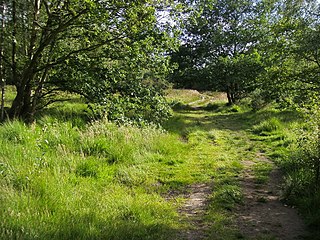
Wimbledon Common is a large open space in Wimbledon, southwest London. There are three named areas: Wimbledon Common, Putney Heath, and Putney Lower Common, which together are managed under the name Wimbledon and Putney Commons totalling 460 hectares. Putney Lower Common is set apart from the rest of the Common by a minimum of 1 mile of the built-up western end of Putney.

Beverley Brook is a 14.3 km (8.9 mi)-long river in the south-western suburbs of London, England. It rises in Worcester Park and joins the River Thames to the north of the Putney Embankment at Barn Elms, having flowed through the green spaces of Wimbledon Common, Richmond Park, Barnes Common and Putney Lower Common on its course. It is followed for much of its course by the Beverley Brook Walk.
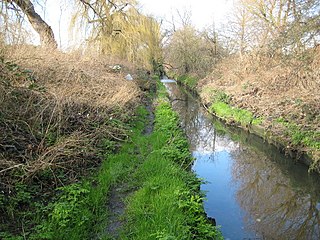
Pyl Brook is a small stream in southwest London. It is a tributary of Beverley Brook, which is a tributary of the River Thames. Pyl Brook has two sources. The 5.3 kilometre main brook rises in Sutton Common in Sutton and flows through the London Borough of Merton to join Beverley Brook at Beverley Park in New Malden. The 3.9 kilometre East Pyl Brook also rises in Sutton and flows through Merton, joining the main Pyl east of Grand Drive in Raynes Park.

The London Borough of Ealing, one of the outer London boroughs although not on the periphery, has over 100 parks and open spaces within its boundaries. These include allotments, cemeteries, playgrounds, and golf courses in addition to the larger open spaces such as nature conservation areas.

London Wildlife Trust (LWT), founded in 1981, is a local nature conservation charity for Greater London. It is one of 46 members of the Royal Society of Wildlife Trusts, each of which is a local nature conservation charity for its area. The Trust aims to protect London's wildlife and wild spaces, and it manages 36 nature reserves in Greater London. The Trust provides education services for schools. Local groups work on reserves and organise walks.

Herts and Middlesex Wildlife Trust manages over 40 nature reserves covering nearly 810 hectares north of London, in Hertfordshire and the historic county of Middlesex, part of which is divided between the London boroughs of Barnet, Enfield, Harrow and Hillingdon. It has over 21,000 members, and is one of 46 Wildlife Trusts across the UK. It is a Registered Charity, with its Registered Office in St Albans, and had an income in the year to 31 March 2014 of over £1.5 million.

Totteridge Fields is a 97-hectare Site of Metropolitan Importance for Nature Conservation (SINC) in Totteridge in the London Borough of Barnet. The SINC includes the privately owned Highwood Hill, and at the western end is a seven-hectare Local Nature Reserve owned by Barnet Council and managed by the London Wildlife Trust.

Oak Hill Wood is a 10-hectare Local Nature Reserve (LNR) and a Site of Borough Importance for Nature Conservation Grade I, in East Barnet, London. It is owned by the London Borough of Barnet, and part of it is a 5.5-hectare nature reserve managed by the London Wildlife Trust.

Gunnersbury Triangle is a 2.57-hectare (6.4-acre) local nature reserve in Chiswick, in the London boroughs of Ealing and Hounslow, immediately to the east of Gunnersbury. It was created in 1983 when, for the first time in Britain, a public inquiry ruled that a planned development of the land could not go ahead because of its value for nature. It opened as a nature reserve in 1985.
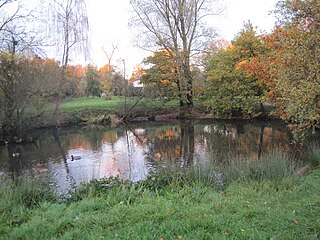
Totteridge Green is a five hectare Site of Borough Importance for Nature Conservation, Grade II, in Totteridge in the London Borough of Barnet. It is also registered common land.

Mill Hill Old Railway Nature Reserve is a 2.3-hectare (5.7-acre) Site of Borough Importance for Nature Conservation, Grade II, in Mill Hill in the London Borough of Barnet.
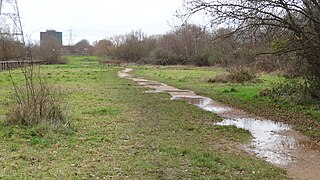
Wandle Meadow Nature Park is a 4.15 hectare local nature reserve and Site of Borough Importance for Nature Conservation, Grade 1, in Wimbledon in the London Borough of Merton. It is owned and managed by Merton Council.

Morden Park is a 50-hectare (120-acre) public park and Site of Borough Importance for Nature Conservation, Grade 1, in the district of Morden Park in the London Borough of Merton. Of this, 28 hectares is a Local Nature Reserve. It is owned and managed by Merton Council. It includes Morden Park House.
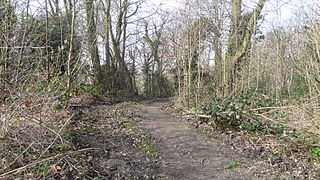
Bramley Bank is a 10.3 hectare local nature reserve in Upper Shirley in the London Borough of Croydon. It is owned by Croydon Council and managed by the London Wildlife Trust.

Wilderness Island is the 2.7 hectare island between the Wandle and Wrythe in Carshalton in the London Borough of Sutton. It is designated a Local Nature Reserve and a Site of Metropolitan Importance for Nature Conservation, is owned by Sutton Council and is managed by the London Wildlife Trust.
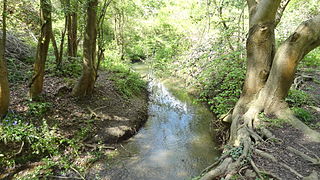
Castle Hill is a 3.5-hectare (8.6-acre) scheduled monument, local nature reserve and Site of Borough Importance for Nature Conservation, Grade 1, in Chessington in the Royal Borough of Kingston upon Thames, London. It is owned by Merton College, Oxford, and leased to Kingston Council. The site is managed by the Lower Mole Countryside Management Project.

Yeading Brook Meadows is a 17 hectare Local Nature Reserve (LNR) in Yeading in the London Borough of Hillingdon. It is owned by Hillingdon Council and managed by the London Wildlife Trust (LWT). In the north it adjoins Ten Acre Wood across the Golden Bridge and Charville Lane; it then stretches south along the banks of the Yeading Brook to Yeading Lane. The reserve is also part of the Yeading Brook Meadows Site of Metropolitan Importance for Nature Conservation, which includes two neighbouring LNRs managed by the London Wildlife Trust, Ten Acre Wood and Gutteridge Wood and Meadows.